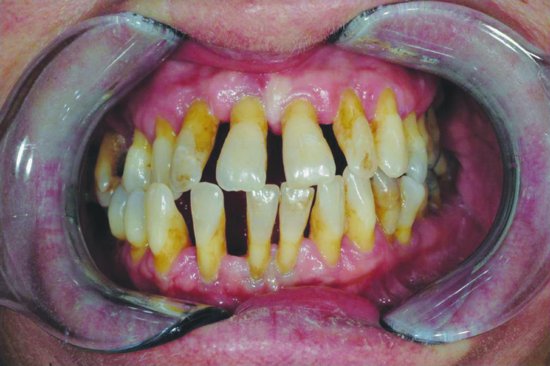Chapter 4
Periodontal disease
WHAT IS CHRONIC PERIODONTITIS?
Chronic periodontitis (Figure 4.1) describes the inflammation and gradual destruction of the periodontium (the supporting structure of the tooth).
Figure 4.1 Chronic adult periodontal disease (© Dr Ian Bellamy. Reproduced with permission)

Chronic periodontitis may look like chronic gingivitis, but can be distinguished by:
- Periodontal probing (depth of pocket is greater than 3 mm).
- X-rays, which show loss of bone support.
- Teeth may be loose.
- Damage is not reversible.
Remember! It is important that the oral health educator (OHE) can distinguish between chronic gingivitis (the continual but superficial inflammation of the gingivae) and chronic periodontitis (the gradual destruction of the periodontium).
Who does it affect?
In the UK Adult Dental Health Survey (2009), only 17% of dentate adults had no evidence of periodontal disease at the most stringent threshold [1]. Good periodontal health was more common among adults under 45 years old than in older age groups. For example, 20% of dentate adults aged between 25 and 34 years had very healthy periodontal tissues compared with 14% between 45 and 54 years and 10% above 55 years [1]. Twenty-one per cent of dentate adults from managerial and professional occupation households had very healthy periodontal tissues compared with 16% of adults of intermediate occupations and 12% of manual occupation households [1].
A growing body of research also suggests that there is an association between chronic periodontitis and certain systemic (body) conditions, such as premature births and low birth weights [2]. Studies have shown a link between periodontitis and coronary heart disease, and people with heart disease have an increased risk of periodontal disease. Acute coronary syndrome, high blood pressure (hypertension) and high cholesterol have also been associated with periodontal disease [3]. The more severe the periodontitis, the greater the risk of heart problems.
Primary causes of chronic periodontitis
Chronic periodontitis is often, but not always, a progression of chronic gingivitis, and is primarily caused by the enzymes and toxins of mature plaque bacteria which gradually break down the tissues of the periodontium in a susceptible host [4]. For most patients, chronic gingivitis does not progress, but 10–15% of patients are susceptible to chronic periodontitis [3]. The onset of periodontitis in these patients is thought to be due to a genetic abnormality, which causes a change in the behaviour of cytokines (substances which regulate the movement of immune system cells) and subsequent destruction of bones. This genetic basis explains why periodontitis frequently affects members of the same family.
Secondary risk factors in the development of periodontitis
Secondary factors are important in the development of periodontitis, and include:
- Smoking – the most important risk factor. Periodontal disease is more common in smokers than non-smokers [2]. Treatment response in smokers is also poorer than non-smokers. Smoking is thought to:
- Reduce blood flow in the gingivae.
- Reduce white blood cell mobility and function.
- Impair healing.
- Increase inflammatory substances (cytokines).
- Poor oral hygiene – failure to clean interdentally leading to plaque accumulation.
- Age – older people are more likely to have chronic periodontitis, due to being exposed to plaque for a longer period than younger patients.
- Plaque retention factors – poorly finished/worn fillings, dentures, crowns, bridges and supragingival and subgingival calculus (see Chapter 2).
- Crowding and malocclusion – one of the reasons for carrying out orthodontic treatment in childhood is to prevent periodontal disease from occurring later. Bone loss associated with malocclusion caused by abfraction (see Chapter 6) is usually localised and not associated with poor oral hygiene.
- Carious cavities – plaque retentive ledges.
- High fraenum insertion – usually found buccally on lower anteriors. The fraenum is a fold of mucous membrane, which limits the movement of the lower lip. If the insertion of the membrane is high on the gingivae it can prevent effective oral hygiene and cause ginigval recession.
- Systemic conditions (see Chapter 8) – for example, patients with diabetes, Down’s syndrome, immunological disorders and those who experience hormonal changes (e.g. pregnancy and puberty).
Features of chronic periodontitis
Features of chronic periodontitis include:
- Often occurs in middle age.
- Usually progresses slowly.
- Can have unpredictable bursts of activity (active phases may need clinical intervention).
- Can result from the progression of gingivitis, but not always – many p/>
Stay updated, free dental videos. Join our Telegram channel

VIDEdental - Online dental courses


